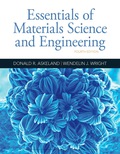
(a)
Interpretation:
The total β % and the % eutectic microconstituent for 10%Sn at room temperature needs to be determined.
Concept Introduction:
The compound formula of Lead-Tin alloy is designated by 'Pb-Sn'.
- It appears in solid form.
- It appears in various shapes like wire, ingot, foil, bar, ribbon etc.
- It appears in silver color.
- Its melting point is 182-215 degree Celsius.
Lead-Tin are widely used as soldering alloys. They are compatible for all types of uses.
Answer to Problem 11.26P
The Total % β and the % eutectic microconstituent at room temperature for 10%Sn is 8.2% and 0% respectively.
Explanation of Solution
Given:
10%Sn
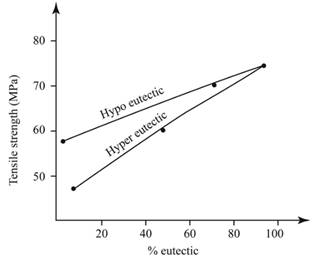
Calculations:
From the graph,
For % β = 10−299−2 =8.2%
% Eutectic = 0.
Thus, the evaluated value of % β and the % eutectic microconstituent at room temperature for 10% Sn is calculated as 8.2% and 0% respectively.
(b)
Interpretation:
The total β % and the % eutectic microconstituent for 20%Sn at room temperature needs to be determined.
Concept Introduction:
The compound formula of Lead-Tin alloy is designated by 'Pb-Sn'.
- It appears in solid form.
- It appears in various shapes like wire, foil, bar, ribbon etc.
- It appears in silver color.
- Its melting point is 182-215 degree Celsius.
Lead-Tin are widely used as soldering alloys. They are compatible for all types of uses.
Answer to Problem 11.26P
The Total % β and the % eutectic microconstituent at room temperature for 20%Sn is 18.6% and 2.3% respectively.
Explanation of Solution
Given:
20%Sn
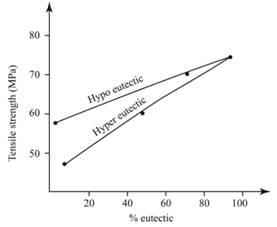
Calculations:
From the graph,
For % β = 20−299−2= 18.6%
% Eutectic = 50−1961.9−19 =2.3%
The evaluated value of % β and the % eutectic microconstituent at room temperature for 20% Sn is calculated as 18.6% and 2.3% respectively.
(c)
Interpretation:
The total β % and the % eutectic microconstituent for 50%Sn at room temperature needs to be determined.
Concept Introduction:
The compound formula of Lead-Tin alloy is designated by 'Pb-Sn'.
- It appears in solid form.
- It appears in various shapes like wire, foil, bar, ribbon etc.
- It appears in silver color.
- Its melting point is 182-215 degree Celsius.
Lead-Tin are widely used as soldering alloys. They are compatible for all types of uses.
Answer to Problem 11.26P
The Total % β and the % eutectic microconstituent at room temperature for 50%Sn is 49.5% and 72.3% respectively.
Explanation of Solution
Given:
50%Sn
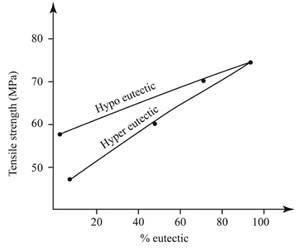
Calculations:
From the diagram,
For % β = 50−299−2=49.5%
% Eutectic = 60−1961.9−19=72.3%
The evaluated value of % β and the % eutectic microconstituent at room temperature for 50% Sn is calculated as 49.5% and 72.3% respectively.
(d)
Interpretation:
The total β % and the % eutectic microconstituent for 60%Sn at room temperature needs to be determined.
Concept Introduction:
The compound formula of Lead-Tin alloy is designated by 'Pb-Sn'.
- It appears in solid form.
- It appears in various shapes like wire,foil, bar, ribbon etc.
- It appears in silver color.
- Its melting point is 182-215 degree Celsius.
Lead-Tin are widely used as soldering alloys. They are compatible for all types of uses.
Answer to Problem 11.26P
The Total % β and the % eutectic microconstituent at room temperature for 60%Sn is 59.8% and 95.6% respectively.
Explanation of Solution
Given:
60%Sn
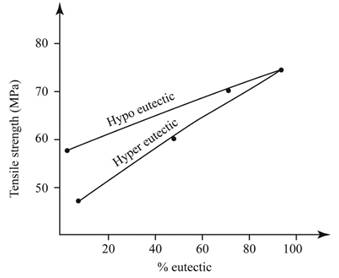
Calculations:
From the graph,
For % β = 60−299−2=59.8%
% Eutectic = 97.5−1961.9−19=95.6%
The evaluated value of % β and the % eutectic microconstituent at room temperature for 60% Sn is calculated as 59.8% and 95.6% respectively.
(e)
Interpretation:
The total β % and the % eutectic microconstituent for 80%Sn at room temperature needs to be determined.
Concept Introduction:
The compound formula of Lead-Tin alloy is designated by 'Pb-Sn'.
- It appears in solid form.
- It appears in various shapes like wire, foil, bar, ribbon etc.
- It appears in silver color.
- Its melting point is 182-215 degree Celsius.
Lead-Tin are widely used as soldering alloys. They are compatible for all types of uses.
Answer to Problem 11.26P
The Total % β and the % eutectic microconstituent at room temperature for 80%Sn is 80.4% and 49.2% respectively.
Explanation of Solution
Use spreadsheet to tabulate the % total β and % eutectic micro constituent as in table (1)
| Composition of % Sn in entire Pb−sn phase diagram | Tensile Strength ( MPa) | Total % β phase | % Eutectic |
| 10 | 30 | 8.2 | 0 |
| 20 | 40 | 18.6 | 2.3 |
| 50 | 50 | 49.5 | 72.3 |
| 60 | 60 | 59.8 | 95.6 |
| 80 | 70 | 80.4 | 49.6 |
| 95 | 80 | 95.9 | 7 |
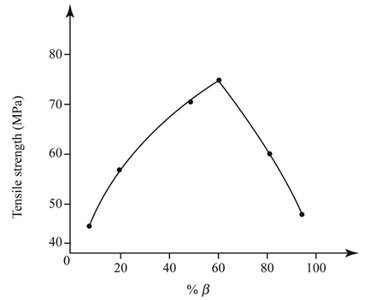
Given:
80%Sn
Calculations:
From the graph:
For % β = 80−299−2=80.4%
% Eutectic = 97.5−8097.5−61.9=49.2%
Thus, by using the expression of eutectic, the required value obtained is 49.2%.
(f)
Interpretation:
The total β % and the % eutectic microconstituent for 95%Sn at room temperature needs to be determined.
Concept Introduction:
The compound formula of Lead-Tin alloy is designated by 'Pb-Sn'.
- It appears in solid form.
- It appears in various shapes like wire, foil, bar, ribbon etc.
- It appears in silver color.
- Its melting point is 182-215 degree Celsius.
Lead-Tin are widely used as soldering alloys. They are compatible for all types of uses.
Answer to Problem 11.26P
The Total % β and the % eutectic microconstituent at room temperature for 95%Sn is 95.9% and 7.0% respectively.
Explanation of Solution
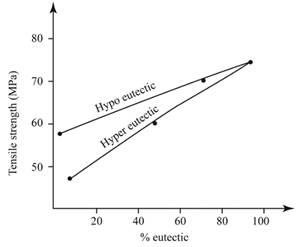
Given:
95%Sn
Calculations:
For % β = 95−299−2=95.9%
% Eutectic = 97.5−9597.5−61.9=7.0%
(Mention Graph)
After Studying the graph of tensile strength vs % β we can conclude that as tensile strength increases to its maximum value of 7800psi at % β = 60%.
The evaluated value of % β and the % eutectic microconstituent at room temperature for 95% Sn is calculated as 95.9% and 7.0% respectively.
Want to see more full solutions like this?
Chapter 11 Solutions
Essentials Of Materials Science And Engineering
- Debugging in Python can be achieved using IDE built-in debugging features or using specific-purpose debugging tools. Evaluate the options presented and select the most appropriate bug-reporting tools. Select one (1) correct response. Question 10 options: Sentry, Rollbar and Glichtip Komodo, CoffeeMug and ZeroBug PyCharm, ZeroBug and PyBugarrow_forwardLiquid hexane flows through a counter flow heat exchanger at 5 m3/h as shown in Figure E5.5.The hexane enters the heat exchanger at 90°C. Water, flowing at 5 m3/h, is used to cool the hexane.The water enters the heat exchanger at 15°C. The UA product of the heat exchanger is found to be2.7 kW/K. Determine the outlet temperatures of the hot and cold fluids and the heat transfer ratebetween them using LMTD method.arrow_forwardSolve this problem and show all of the workarrow_forward
- Determine the fluid outlet temperatures and the heat transfer rate for the counter flow heatexchanger described in Problem 3 using the ε-NTU model. Assume that the properties can beevaluated at the given fluid inlet temperatures.arrow_forwardSection View - practice Homework 0.5000 3.0000 2,0000 1.0000arrow_forwardusing r languagearrow_forward
- Drawing the section view for the following multiview drawing AutoCAD you see the section pratice I need to show how to autocadarrow_forwardDetermine the global stiffness matrix of the beam shown in Fig. 3. Assume supports at 1 and 3 are rollers and the support at 2 is a pinned support. Indicate the degrees of freedom in all the stiffness matrices. EI is constant, w=60kN/m, L1=1.25m and L2=3.45marrow_forwardThe joint probability density function of two discrete random variables X and Y is given by p(x, y)=c(2x+y), where x and y can assume all integers such that 0≤ x≤2, 0≤ y ≤ 3, and p (x, y)= 0 otherwise. a) Find the value of the constant c. (c) Find P(X≥1, Y≤2). (b) Find P(X=2, Y= 1).arrow_forward
- A wattmeter is connected with the positive lead on phase "a" of a three-phase system. The negative lead is connected to phase "b". A separate wattmeter has the positive lead connected to phase "c". The negative lead of this wattmeter is connected also to phase "b". If the input voltage is 208 volts line-to- line, the phase sequence is "abc" and the load is 1200 ohm resistors connected in "Y", what is the expected reading of each of the wattmeters? (Hint: draw a phasor diagram)arrow_forwardusing r languagearrow_forwardusing r langaugearrow_forward
 MATLAB: An Introduction with ApplicationsEngineeringISBN:9781119256830Author:Amos GilatPublisher:John Wiley & Sons Inc
MATLAB: An Introduction with ApplicationsEngineeringISBN:9781119256830Author:Amos GilatPublisher:John Wiley & Sons Inc Essentials Of Materials Science And EngineeringEngineeringISBN:9781337385497Author:WRIGHT, Wendelin J.Publisher:Cengage,
Essentials Of Materials Science And EngineeringEngineeringISBN:9781337385497Author:WRIGHT, Wendelin J.Publisher:Cengage, Industrial Motor ControlEngineeringISBN:9781133691808Author:Stephen HermanPublisher:Cengage Learning
Industrial Motor ControlEngineeringISBN:9781133691808Author:Stephen HermanPublisher:Cengage Learning Basics Of Engineering EconomyEngineeringISBN:9780073376356Author:Leland Blank, Anthony TarquinPublisher:MCGRAW-HILL HIGHER EDUCATION
Basics Of Engineering EconomyEngineeringISBN:9780073376356Author:Leland Blank, Anthony TarquinPublisher:MCGRAW-HILL HIGHER EDUCATION Structural Steel Design (6th Edition)EngineeringISBN:9780134589657Author:Jack C. McCormac, Stephen F. CsernakPublisher:PEARSON
Structural Steel Design (6th Edition)EngineeringISBN:9780134589657Author:Jack C. McCormac, Stephen F. CsernakPublisher:PEARSON Fundamentals of Materials Science and Engineering...EngineeringISBN:9781119175483Author:William D. Callister Jr., David G. RethwischPublisher:WILEY
Fundamentals of Materials Science and Engineering...EngineeringISBN:9781119175483Author:William D. Callister Jr., David G. RethwischPublisher:WILEY





